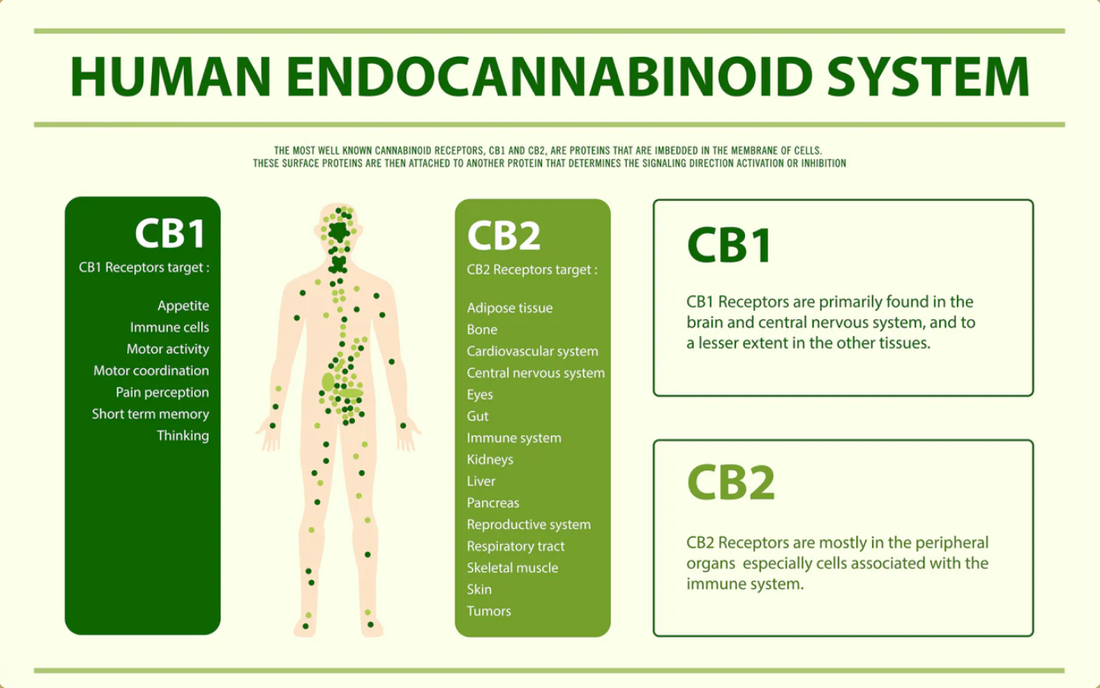
The Endocannabinoid System
Share
Understanding the Endocannabinoid System: CB1 and CB2 Receptors and Their Role in the Human BodyThe endocannabinoid system (ECS) is a fascinating and complex network in the human body that plays a critical role in maintaining balance and regulating various physiological processes. Discovered in the 1990s during research on cannabis, the ECS is a biological system that interacts with endocannabinoids—naturally occurring compounds in our bodies—as well as phytocannabinoids, like those found in cannabis. At the heart of this system are two primary receptors: CB1 and CB2. In this blog, we’ll explore what the ECS does, how CB1 and CB2 receptors function, and their interactions with the body to support health and homeostasis.What is the Endocannabinoid System?The ECS is a signaling system found in nearly every major organ and tissue of the human body, as well as in other mammals. Its primary function is to maintain homeostasis, the body’s ability to regulate internal conditions like temperature, mood, appetite, and immune response, despite external changes. The ECS consists of three main components:
Note: This blog is for informational purposes only and does not constitute medical advice. Always consult a healthcare professional before using cannabis or related products.
- Endocannabinoids: These are naturally produced molecules, such as anandamide (AEA) and 2-arachidonoylglycerol (2-AG), that bind to cannabinoid receptors to trigger physiological responses.
- Cannabinoid Receptors: The two primary receptors, CB1 and CB2, are found on cell surfaces and act like locks that endocannabinoids or external cannabinoids (like THC or CBD) can "unlock."
- Enzymes: These break down endocannabinoids after they’ve done their job. Key enzymes include fatty acid amide hydrolase (FAAH), which degrades anandamide, and monoacylglycerol lipase (MAGL), which breaks down 2-AG.
- Mood and Emotions: CB1 receptors in the amygdala and prefrontal cortex help regulate emotions and stress responses. This is why cannabis use can sometimes induce euphoria or, conversely, anxiety in some individuals.
- Appetite and Metabolism: CB1 receptors in the hypothalamus stimulate appetite (the “munchies” effect associated with cannabis) and play a role in energy balance and fat storage.
- Pain Modulation: CB1 receptors in the spinal cord and brain can reduce pain perception by dampening pain signals.
- Memory and Learning: In the hippocampus, CB1 receptors influence short-term memory and cognitive processes, which explains why high doses of THC can impair memory temporarily.
- Motor Control: Found in the basal ganglia and cerebellum, CB1 receptors help coordinate movement, which is why cannabis can affect coordination.
- Immune Regulation: CB2 receptors help control inflammation by suppressing excessive immune responses. This makes them a target for conditions like autoimmune diseases or chronic inflammation.
- Pain and Inflammation: CB2 activation in peripheral tissues can reduce inflammation-related pain, such as in arthritis or neuropathic pain, without causing psychoactive effects.
- Gut Health: CB2 receptors in the gastrointestinal tract regulate gut motility and inflammation, which is why cannabinoids are studied for conditions like irritable bowel syndrome (IBS).
- Bone Health: Emerging research suggests CB2 receptors play a role in bone remodeling and may help in conditions like osteoporosis.
- Neuroprotection: In the brain, CB2 receptors in microglia can reduce neuroinflammation, potentially offering benefits in neurodegenerative diseases like Alzheimer’s or multiple sclerosis.
- Pain Management: CB1 reduces pain signaling in the brain and spinal cord, while CB2 tackles inflammation at the site of injury, creating a complementary effect.
- Neuro-Immune Crosstalk: In conditions like traumatic brain injury, CB1 receptors in neurons and CB2 receptors in microglia collaborate to reduce inflammation and protect brain tissue.
- Homeostasis: Both receptors respond to endocannabinoids to fine-tune physiological responses, ensuring the body adapts to stressors like injury, infection, or emotional distress.
- Chronic pain (e.g., neuropathic pain, arthritis)
- Neurological disorders (e.g., epilepsy, Parkinson’s disease)
- Mental health conditions (e.g., anxiety, depression)
- Inflammatory diseases (e.g., Crohn’s disease, rheumatoid arthritis)
- Metabolic disorders (e.g., obesity, diabetes)
Note: This blog is for informational purposes only and does not constitute medical advice. Always consult a healthcare professional before using cannabis or related products.
